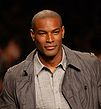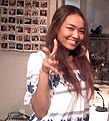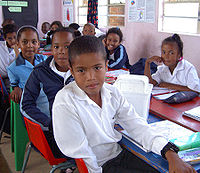- Afro-Asian
-
For other uses, see Afro Asians (African Asians).
Afro-Asian 







Notable Afro-Asians:
Robert C. Scott • Bryan Clay • Kamala Harris • Naomi Campbell • Staceyann Chin • Tyson Beckford • Jean Ping • Chanel Iman • Crystal KayTotal population Official population numbers are unknown;
United States: 106,782 (2000)[1]Regions with significant populations  United States •
United States •  Puerto Rico •
Puerto Rico •  Jamaica •
Jamaica •  Trinidad and Tobago •
Trinidad and Tobago •  Guyana •
Guyana •  South Africa •
South Africa •  Kenya •
Kenya •  United Kingdom •
United Kingdom •  Réunion •
Réunion •  Suriname •
Suriname •  India •
India •  Madagascar
MadagascarAfro-Asian or Blasian is a moniker used to refer a person of mixed Black and Asian (specifically East or Southeast Asian) ancestry.[2]
Contents
History
Latin America
In Latin America, significant numbers of Chinese first started arriving in the mid 19th century as part of the Coolie slave trade. By the mid 20th century, Cuba and Peru had the largest Chinese populations. By the end of WWII, there were considerable high numbers of Latin American descended from Chinese fathers and local women. One of the most famous of these is the Chinese-Afro-Cuban artist Wilfredo Lam, known as the Cuban Picasso. There are also small numbers of Latin American residents of Asian and African descent in countries like Puerto Rico and Dominican Republic.
Madagascar
The majority of the population of Madagascar is primarily a mixture in varying degrees of Indonesian and Bantu settlers from Southeast Asia and East Africa, respectively.[3][4] Years of intermarriages created the Malagasy people, who primarily speak Malagasy, an Austronesian language with Bantu influences.[4]
South Africa
The Cape Coloured population descend from indigenous Khoisan and Xhosa peoples; European immigrants; and Malagasy, Ceylonese and South-East Asian (primarily Indonesian) laborers and slaves brought by the Dutch from the mid-17th Century to the late 18th Century. The majority of Coloureds, particularly in the Western Cape and Northern Cape, speak Afrikaans as a first language, while those in other parts of South Africa tend to speak English as well. Coloureds with Javanese or other Indonesian ancestry may often be regarded as Cape Malay and are primarily Muslims, while the majority of Coloureds are Christian (generally Protestant) or agnostic. Due to similar social adversities experienced under the Apartheid regime from the late 1940s to the late 1980s, Coloured and Indigenous South African communities generally fall under the Black social category when it comes to employment and affirmative action policies.[5]
Southeast Asia
During the Vietnam War, African-American servicemen had children with local Vietnamese women. Some of these children were abandoned by the Vietnamese family, or sent to orphanages. Many orphans and children were airlifted to adopting families in the United States in 1975 during "Operation Babylift" before the fall of South Vietnam. The Afro-Vietnamese (or Afro-Amerasian) children suffered much discrimination in Vietnam at that time. [6] There was also some controversy as to how these orphaned Afro-Amerasian children were placed in new homes in the United States.[7]
The Caribbean
In the 1860s, Chinese and East Indian immigrants arrived in the West Indies as indentures servants. Chinese male laborers and male migrants who went to Peru, Cuba, Guyana, Madagascar, America, Jamaica, Trinidad where Chinese often intermarried with local black women which resulted in large population of mullato children. According to the 1946 Census from Jamaica and Trinidad alone, 12,394 Chinese were located between Jamaica and Trinidad. 5,515 of those who lived in Jamaica were Chinese Jamaican and another 3,673 were Chinese-Trinidadians living in Trinidad.
In Haiti, there is a small percentage within the minority who are of Asian descent. For example, Haitian painter Edouard Wah was born to a Chinese father and Haitian mother.
In Jamaica, Guyana, and Trinidad a percentage of the population of people are of Indian descent, some of whom have contributed to Afro-Asian Caribbean children.[citation needed]
United Kingdom
The UK population includes people of mixed-race and some Afro-Asian peoples. Some Afro-Asian Britons include Naomi Campbell, Freema Agyeman and David Jordan.[citation needed]
United States
In 1882, the Chinese Exclusion Act was passed and Chinese workers who chose to stay in the U.S. could no longer be with their wives who stayed behind in China. Because White Americans looked at Chinese labor workers as stealing employment, they were harassed and discriminated against. Many Chinese men settled in black communities and in turn married Black women.[8]
As of the census of 2000, there were 106,782 Afro-Asian individuals in the United States.[9]
Kenya
In 1999, Nicholas Kristof of the New York Times reported a surprising encounter on the island of Pate, where he found a village of stone huts. He talked to an elderly man living in the village who said that he was a descendant of Chinese explorers who were shipwrecked there centuries before. The Chinese had supposedly traded with the locals, and had even loaded giraffes onto their ship to take back to China. However, the Chinese ran aground on a nearby reef. Kristof found evidence that confirmed the man's story. Such evidence included the Asian features of the people in the village, plus Asian-looking porcelain artifacts.[10][11]
See also
References
- ^ U.S. Census Bureau, Census 2000
- ^ Schema Magazine - Afro-Asian | Blasian : hapa collaboration
- ^ Glenn Joseph Ames, Distant lands and diverse cultures: the French experience in Asia, 1600-1700, (Greenwood Publishing Group: 2003), p.101.
- ^ a b On the Origins and Admixture of Malagasy: New Evidence from High-Resolution Analyses of Paternal and Maternal Lineages: "all Madagascan living groups show a mixture of uniparental lineages typical of present African and South East Asian populations with only a minor contribution of Y lineages with different origins. Two observations suggest that the Y lineages with "another origin" entered the island in recent times: 1) they are particularly frequent in the Tanosy area (Fort Dauphin), and around Antananarivo, where commercial networks and slave trade had a focus; 2) they matched with haplotypes typical of present Indo-European (Europeans) and Arabic-speaking (Somali) people."
- ^ South African Chinese Become Black; BBC News; 18 June 2008
- ^ Anderson, Wanni Wibulswasdi; Lee, Robert G., Displacements and Diasporas: Asians in the Americas, Rutgers University Press, 2005. ISBN 0-8135-3611-1. For discrimination in Vietnam, cf. p.14. "In another case study, the Vietnamese Afro-Amerasians (Lucious, this volume) suffered severe discrimination in Vietnam, being called 'children of the enemy' ..." And further on p.133, "In Vietnam, Afro-Amerasians experienced the most discrimination because their black skin was perceived as relatively darker than the skin color of other Vietnamese people (especially White Euro-Amerasians)."
- ^ Hicks, Nancy. "Black Agencies Charge Injustice In Placing of Vietnam Children", New York Times, 19 April 1975.
- ^ "The United States". Chinese Blacks in the Americas. Color Q World. http://www.colorq.org/MeltingPot/article.aspx?d=America&x=ChineseBlacks. Retrieved 2008-07-21.
- ^ Le, C. N.. "Multiracial/Hapa Asian Americans". Asian-Nation: The Landscape of Asian America. http://www.asian-nation.org/multiracial.shtml. Retrieved 2008-07-21. "According to the 2000 census, out of the 281,421,906 people living in the U.S., 10,242,998 of them identified themselves as entirely of Asian race (3.6%). Additionally, there were 1,655,830 people who identified themselves as being part Asian and part one or more other races. Asian and Black/African American ... 106,782 ... 0.64% (percentage of total multiracial Asians)"
- ^ 1492: The Prequel, By Nicholas D. Kristof, June 6, 1999, New York Times
- ^ Ancient Chinese Explorers, by Evan Hadingham
External links
- The Indian Diaspora at the UCLA
- Manas project
- African and Asian connections in history
- HalfKorean.com
- www.blasianton.com A community for Blacks, Asians, and Blasians
African diaspora By region AmericasAnglo AmericaBahamas · Belize · Canada (Black Nova Scotians) · Grenada · Guyana · Jamaica (Igbo Jamaican · Coromantee · Jamaican Maroons) · Trinidad & Tobago · United States (Black Hispanic · Black Indians in the U.S. · Black Seminoles · Multiracial American)Hispanic AmericaOther countriesBrazil (Pardo) · Suriname (Surinamese Creoles · Surinamese Maroons)
South Asia Europe Middle East Demographics: LGBT topics (Traditional religions)Emigration from Africa By region AmericasAnglo-AmericaCanada · United StatesAfrican immigrantsEurope Middle East Israel · IraqAsia-Pacific Categories:- Multiracial affairs
- People of Asian descent
- People of Black African descent
Wikimedia Foundation. 2010.

